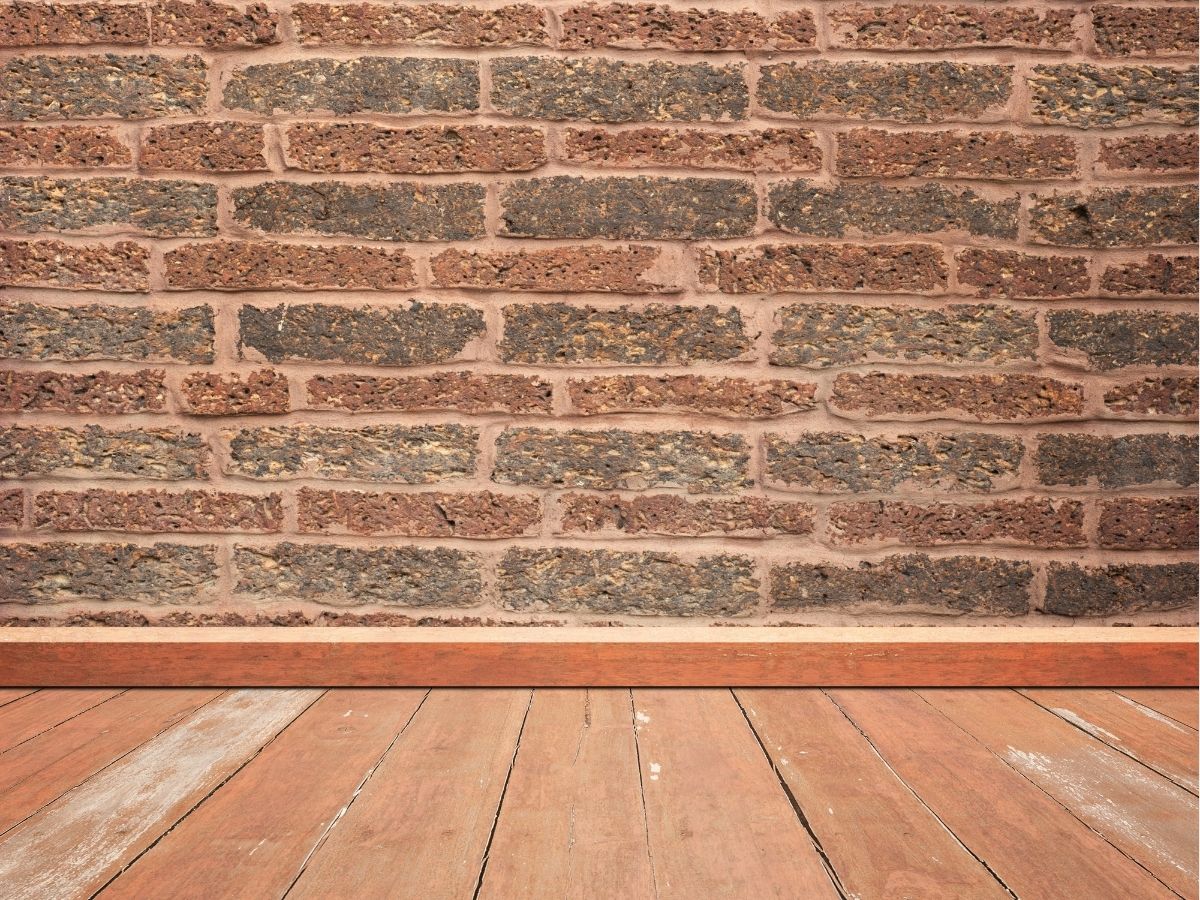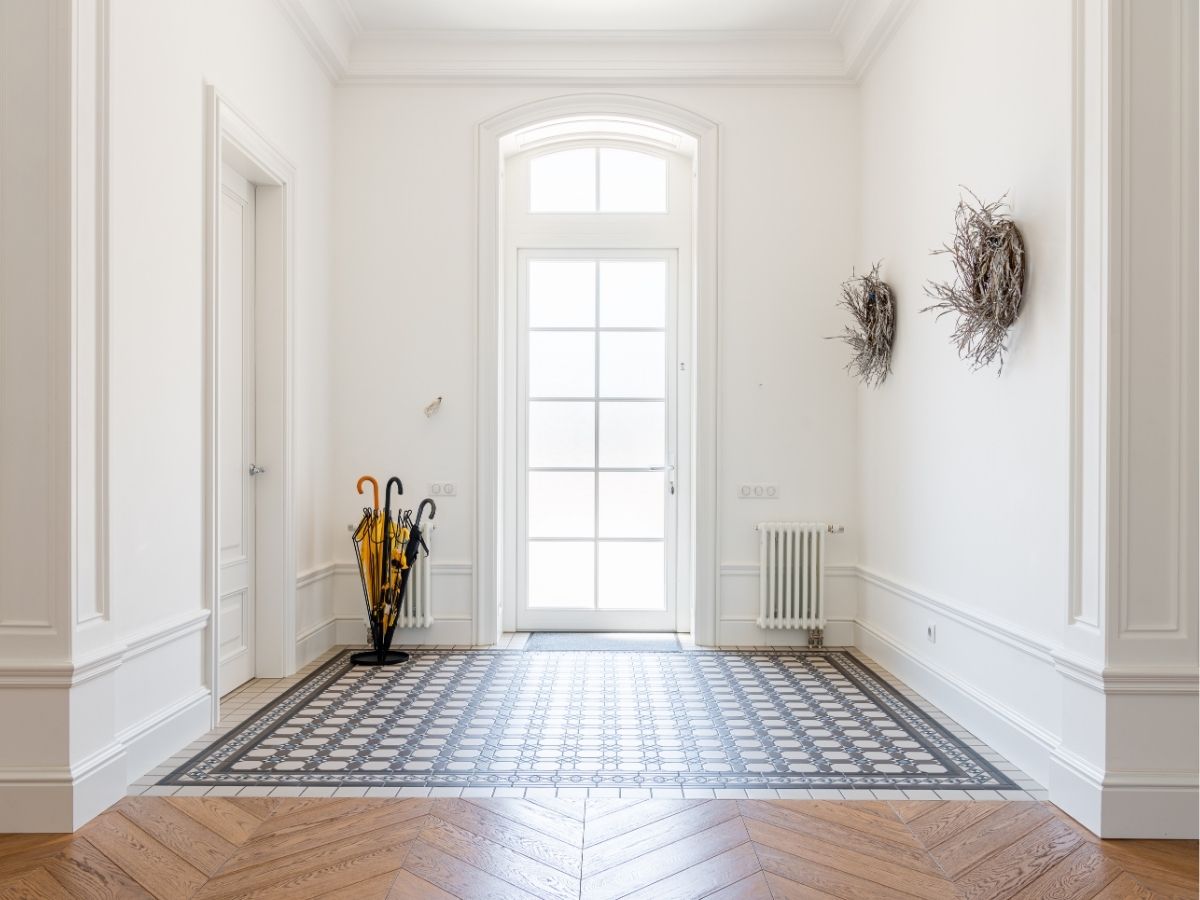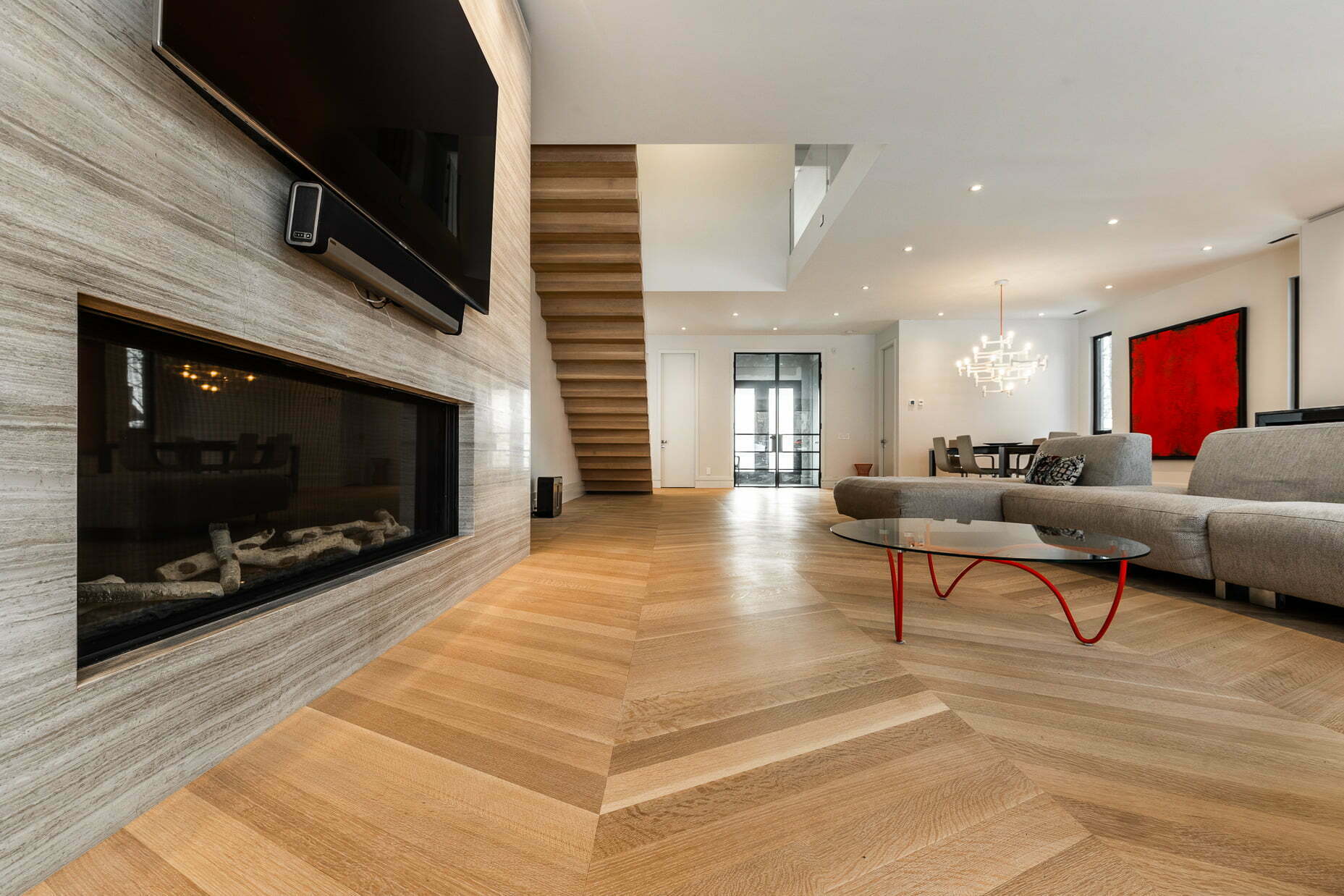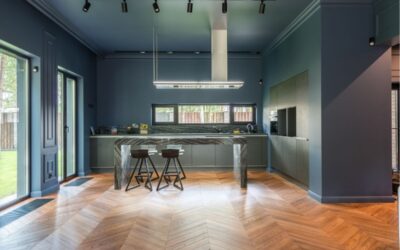Antique floors, rich in history, bring unrivalled personality to our interiors. With their marks of time, warm patina and unique character, they tell stories and bear witness to an often comforting past. These surfaces, though resistant, can suffer from wear, scratches and stains over the years. Fortunately, it’s possible to give them a second life while preserving their vintage look and authenticity. However, antique floors in and around Old Montreal, often located in heritage buildings, require the expertise of a professional to restore them. Their historic value and unique wood species require precise techniques to preserve their original charm.
But if you want to sand an old floor yourself, don’t panic! With a little preparation and the right techniques, this project is perfectly feasible, even for a beginner. Follow our comprehensive guide to make a success of this transformation and reveal the full splendor of your floor.
Table of Contents

Advantages of sanding an old floor
Restoring an old floor by sandblasting offers many advantages, not only aesthetic but also practical. The process of sanding an old floor brings out the natural beauty of the wood, removing scratches, stains and irregularities that have accumulated over time. A restored floor immediately gives your interior a refined, warm appearance.
1- Return on investment
Sanding an old floor is also a wise investment. Rather than replacing a worn floor, sanding an old floor extends its life at a lower cost, while preserving its authenticity. Not only does this reduce long-term expenses, it also increases occupant comfort and satisfaction.
2- Increase the value of your property
Sandblasting an old floor can significantly increase the value of a property. Potential buyers are often attracted by timeless features like wood floors, which add character and quality. In a competitive real estate market, investing in floor restoration can make a real difference in attracting buyers and getting a better return on your home.
Presence of old-growth wood in Old Montreal and surrounding areas
Old Montreal is brimming with historic buildings that showcase the authenticity and charm of old hardwood. This wood, used in the construction of past eras, bears witness to the region’s rich architectural heritage. Each neighborhood has its own unique identity, influenced by the types of wood selected for their properties and local availability at the time.
Saint-Paul district
One of Montreal’s oldest neighborhoods, Saint-Paul, is home to many structures where white pine was favored. This wood, known for its lightness and easy workability, was often used for beams and frames.
Bonsecours district
In the historic Bonsecours district, red oak is predominant. Appreciated for its durability and luxurious appearance, it was often chosen for the floors and staircases of bourgeois homes.
Place d’Armes district
Around the Place d’Armes, you’ll find cherry and black walnut, chosen for their refined grain and robustness. These woods were often used in administrative and religious buildings, lending elegance and prestige to these edifices.
Outlying districts
Montreal’s outlying neighborhoods also offer fascinating examples of the use of old wood, revealing the local preferences and resources of each area:
- Hampstead / Côte-Saint-Luc / Notre-Dame-de-Grâce / Montreal West: These residential neighborhoods often favored durable woods such as white oak and ash, used in the floors and interior woodwork of middle-class homes.
- Verdun / Nuns’ Island: In this waterfront region, cedar and pine were frequently used for their moisture resistance, especially in port structures and canal-side homes.
- Westmount Westmount: Renowned for its luxurious homes, Westmount is marked by the use of exotic woods such as mahogany for custom furniture and decorative woodwork.
- Ville-Mont-Royal Ville-Mont-Royal: This master-planned neighborhood features sturdy wood species such as walnut for its classically styled single-family homes.
- Ville-Marie In the heart of the city, you’ll find a wide variety of woods, from pine for beams to noble woods for the interior finishes of old buildings.
- LaSalle / Lachine / Dorval: These neighborhoods, linked to Montreal’s industrial and port history, frequently used maple and fir wood for the structures and floors of residential and industrial buildings.
- Outremont This elegant neighborhood favored noble woods such as cherry and oak for its prestigious homes and buildings.
This diversity in the use of wood species, whether in Old Montreal or its outlying districts, reflects the ingenuity and know-how of the craftsmen of the time, while telling part of the city’s history and evolution.

Assessing the condition of your old floor
Before sanding an old floor, it’s crucial to assess its current condition. This initial step will enable you to detect any problems and prepare yourself with the necessary tools and materials. Here’s what to look for:
- Scratches or deep cracks: These marks, common on old floors, may need to be filled with wood filler to prevent the cracks from deepening during sanding.
- Water stains or damage: Areas affected by water can weaken wood fibers, making the process of sanding an old floor more delicate. Identify these areas to decide if they require specific repair before you start sanding an old floor.
- Remaining wood thickness: An essential point, especially for floors that have already undergone several restorations. If the thickness of the wood is too thin, intensive sanding could irreparably damage the floor.
- Type of existing finish: Is your floor covered with varnish, oil or wax? Knowing the existing finish will guide you in choosing the tools and methods needed to remove it effectively.
If you have any doubts about the general condition of the floor, or if it looks extremely damaged, it’s advisable to consult a professional. Expert sanding of an old floor can not only avoid costly mistakes, but also guarantee the preservation of your precious floor.
The process of sanding an old floor: A step-by-step guide
Sandblasting an old floor may seem intimidating, but with a little patience and the right tools, it’s an achievable project that can transform your interior. Here are the detailed steps for successfully sanding an old floor:
1. Prepare the room
Good preparation is essential to ensure that you sand an old floor efficiently and avoid complications:
- Remove all furniture, carpets and objects from the room. The surface must be completely clear to allow full access to the floor.
- Thoroughly clean the workpiece to remove any dust, grit or other debris that may interfere with or damage your tools.
- Protect baseboards, walls and other sensitive areas with tape or plastic sheeting to prevent accidental splinters or scratches.
2. Gather your equipment
The right equipment will make the job of sanding an old floor easier and more efficient. Here are the essential tools:
- A drum sander for large surfaces. This is the main tool for removing old coats of finish.
- An edge sander or detail sander to reach corners and hard-to-reach areas.
- Sanding paper of different grits: start with a coarse grit (40 or 60) to remove thick layers, then move on to a medium grit (80) and finish with a fine grit (120 or 150) to obtain a smooth, even surface.
- A powerful vacuum cleaner to remove dust after each sanding pass.
- Personal protective equipment: a dust mask to protect your respiratory tract, goggles and gloves for optimum safety.
3. Sanding an old floor in several passes
Sanding an old floor is a crucial step that must be done with care and method:
- First pass: Use coarse-grit sandpaper to remove old coats of finish (varnish, wax, paint) and smooth out irregularities. Always work in the direction of the wood grain to avoid damaging the surface.
- Second pass: Switch to medium-grain to refine the surface and remove traces left by the first sanding. This pass also prepares the wood for an even finish.
- Final pass: Finish with a fine grain to obtain a soft, perfectly smooth surface, ready to receive the new finish. Take your time with this step, as it guarantees impeccable results.
4. Vacuum thoroughly
Between each sanding pass, it’s essential to clean the surface. Use a powerful vacuum cleaner to remove dust and prevent it from interfering with tools or the application of finishes. Once sanding is complete, wipe with a slightly damp cloth to capture invisible residues and obtain a perfectly clean surface.
5. Choose the right finish
To restore your floor to its former glory, select a finish that will both enhance and protect the wood:
- Varnish for a glossy appearance and long-lasting protection.
- Natural oil for a matte finish that lets wood breathe while protecting it.
- Wax for a warm, authentic look, although more maintenance is required.
With these detailed steps, your floor will regain all its former charm, ready to shine once again at the heart of your interior. So, are you ready to give your floor a second life and transform your space?
Repairing and filling: Preparing the surface
Before applying a new finish, take the time to repair any imperfections in the wood:
- For cracks and holes: Use a wood filler in the color closest to your floor. Apply it with a spatula and smooth out any gaps.
- For gaps between boards: opt for flexible mastic beads, specially designed for wood floors.
Allow the repairs to dry completely before moving on to the next step.
Finishes: Enhancing the charm of your floor
Finishing is the final step that will give your restored floor all its character. Here are a few tips to help you make the right choice:
- Stain: For a vintage, natural look, choose a warm stain or oil finish. You can also add a contemporary touch with a gray or white shade.
- Finish type: polyurethane finishes offer long-lasting protection against wear and scratches, while wax finishes provide a subtle, natural shine.
Apply the finish in thin coats using a brush or suitable roller. Between coats, sand lightly with fine abrasive paper to ensure even application. Follow the drying times indicated by the manufacturer.
Special precautions for old wood floors
Antique wood floors require special care to preserve their unique character and durability. Here are a few tips:
- Avoid aggressive chemicals: Use mild, non-abrasive cleaners to avoid damaging the surface or altering the original patina.
- Monitor humidity: Humidity variations can cause cracking or warping. Maintain a stable humidity level inside.
- Protect against scratches: add protective pads under furniture and avoid walking in high-heeled shoes.
- Regular maintenance: Apply regular maintenance, such as waxing or oiling, to preserve their shine and protect the wood from wear.
These precautions will help maintain the beauty and authenticity of old wood floors for many years to come, and save you from having to sand an old floor often.

Why it’s important to call in a professional to sand an old floor
Sandblasting antique floors in historic districts such as Old Montreal and the surrounding area requires special expertise. These floors, often made from noble and rare species, have not only an aesthetic value but also a heritage dimension. Calling in a professional guarantees a restoration that respects the original materials and preserves the authentic character of the site. What’s more, a professional will be able to assess the condition of the wood, suggest the best repair techniques, and use suitable products to prolong the floor’s durability. This know-how preserves the historical heritage of these emblematic buildings while ensuring their longevity for future generations, whether in the historic heart of Montreal or its outlying neighborhoods.
Discover professional expertise for sanding old floors
Sanding an old floor is a rewarding but demanding task. If you want to achieve impeccable results without the hassle, consider entrusting the task to a sanding professional. With their specialized skills and equipment, they’ll restore your floor to its former beauty, while respecting its integrity.
Ready to transform your floor?
Contact our experts today for a personalized quotation and bring your interior back to life. Sandblasting an old floor means preserving a piece of history while enhancing your living space. Turn your floor into a timeless masterpiece! Request a free quote.
Mebesa offers sandblasting, dust-free sanding and floor installation and finishing services in the following cities: Saint-Hubert, Montreal, Brossard, Boucherville, Sainte-Julie, Saint-Constant, La Prairie, Chambly, Sainte-Catherine, Saint-Lambert, Longueuil, Laval, Delson, Pointe-Claire, Saint-Sauveur, Saint-Jean-sur-Richelieu, Terrebonne, Repentigny, Granby, Kirkland, Châteauguay, Beloeil, Candiac, Saint-Bruno-de-Montarville.
For more information on hardwood flooring, see the following articles:
Montreal South Shore: Floor sanding experts available in over 20 cities
Dust-free wood floor finish, what are the benefits?
Simple 6-step method for sanding hardwood floors
Simple 3-step price estimate for hardwood floor sanding
Frequently asked questions
-
How do I remove scratches from a hardwood floor?
There are several ways to remove scratches from hardwood floors, depending on the severity of the damage. For small surface marks, you can use a touch-up pencil or wood paste in the same shade as your floor. For deeper scratches, a light sanding followed by an application of varnish or protective oil may suffice. For major scratches, we recommend that you consult a professional for complete sanding and restoration.
-
What’s the most resistant wood floor?
In terms of durability and resistance, certain wood species stand out, such as oak, hickory or maple. These types of wood offer a high density that enables them to withstand impacts, scratches and daily wear and tear. Engineered wood floors also combine strength and stability, thanks to their multi-layer design, ideal for supporting high-traffic areas.
-
How do I refinish a hardwood floor?
To give a hardwood floor a new lease on life, start by removing any worn coating or protection. Next, sanding is a crucial step to eliminate imperfections and even out the surface. After this preparation, apply a stain or varnish of your choice to restore the finish and protect the wood. For best results, consider calling in a professional, especially for old or damaged floors, to ensure impeccable renovation.






0 Comments